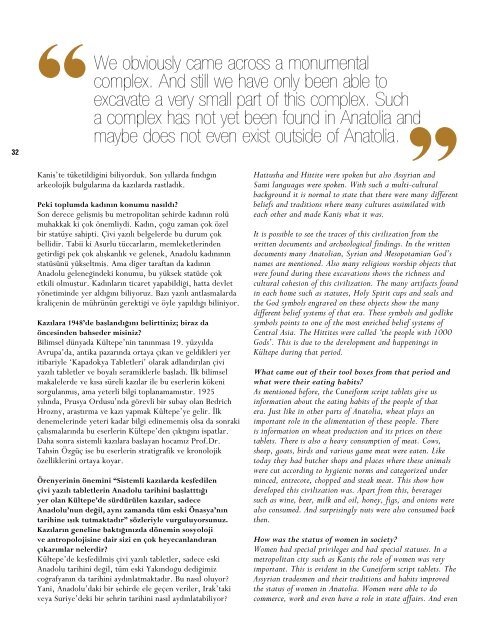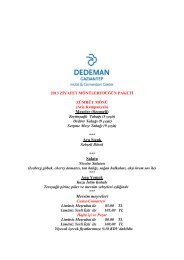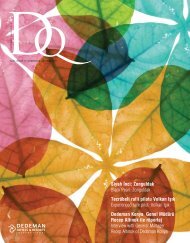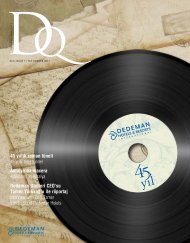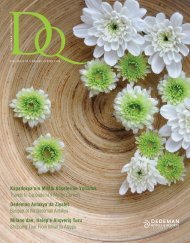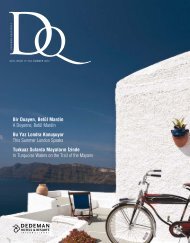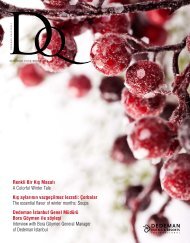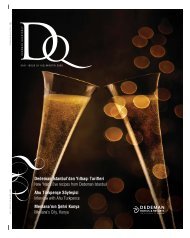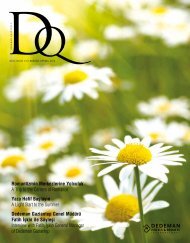You also want an ePaper? Increase the reach of your titles
YUMPU automatically turns print PDFs into web optimized ePapers that Google loves.
32<br />
We obviously came across a monumental<br />
complex. And still we have only been able to<br />
excavate a very small part of this complex. Such<br />
a complex has not yet been found in Anatolia and<br />
maybe does not even exist outside of Anatolia.<br />
Kaniş’te tüketildiğini biliyorduk. Son yıllarda fındığın<br />
arkeolojik bulgularına da kazılarda rastladık.<br />
Peki toplumda kadının konumu nasıldı<br />
Son derece gelişmiş bu metropolitan şehirde kadının rolü<br />
muhakkak ki çok önemliydi. Kadın, çoğu zaman çok özel<br />
bir statüye sahipti. Çivi yazılı belgelerde bu durum çok<br />
bellidir. Tabii ki Asurlu tüccarların, memleketlerinden<br />
getirdiği pek çok alışkanlık ve gelenek, Anadolu kadınının<br />
statüsünü yükseltmiş. Ama diğer taraftan da kadının<br />
Anadolu geleneğindeki konumu, bu yüksek statüde çok<br />
etkili olmuştur. Kadınların ticaret yapabildiği, hatta devlet<br />
yönetiminde yer aldığını biliyoruz. Bazı yazılı antlaşmalarda<br />
kraliçenin de mührünün gerektiği ve öyle yapıldığı biliniyor.<br />
Kazılara 1948’de başlandığını belirttiniz; biraz da<br />
öncesinden bahseder misiniz<br />
Bilimsel dünyada Kültepe’nin tanınması 19. yüzyılda<br />
Avrupa’da, antika pazarında ortaya çıkan ve geldikleri yer<br />
itibariyle ‘Kapadokya Tabletleri’ olarak adlandırılan çivi<br />
yazılı tabletler ve boyalı seramiklerle başladı. İlk bilimsel<br />
makalelerde ve kısa süreli kazılar ile bu eserlerin kökeni<br />
sorgulanmış, ama yeterli bilgi toplanamamıştır. 1925<br />
yılında, Prusya Ordusu’nda görevli bir subay olan Bedrich<br />
Hrozny, araştırma ve kazı yapmak Kültepe’ye gelir. İlk<br />
denemelerinde yeteri kadar bilgi edinememiş olsa da sonraki<br />
çalışmalarında bu eserlerin Kültepe’den çıktığını ispatlar.<br />
Daha sonra sistemli kazılara başlayan hocamız Prof.Dr.<br />
Tahsin Özgüç ise bu eserlerin stratigrafik ve kronolojik<br />
özelliklerini ortaya koyar.<br />
Örenyerinin önemini “Sistemli kazılarda keşfedilen<br />
çivi yazılı tabletlerin Anadolu tarihini başlatttığı<br />
yer olan Kültepe’de sürdürülen kazılar, sadece<br />
Anadolu’nun değil, aynı zamanda tüm eski Önasya’nın<br />
tarihine ışık tutmaktadır” sözleriyle vurguluyorsunuz.<br />
Kazıların geneline baktığınızda dönemin sosyoloji<br />
ve antropolojisine dair sizi en çok heyecanlandıran<br />
çıkarımlar nelerdir<br />
Kültepe’de keşfedilmiş çivi yazılı tabletler, sadece eski<br />
Anadolu tarihini değil, tüm eski Yakındoğu dediğimiz<br />
coğrafyanın da tarihini aydınlatmaktadır. Bu nasıl oluyor<br />
Yani, Anadolu’daki bir şehirde ele geçen veriler, Irak’taki<br />
veya Suriye’deki bir şehrin tarihini nasıl aydınlatabiliyor<br />
Hattusha and Hittite were spoken but also Assyrian and<br />
Sami languages were spoken. With such a multi-cultural<br />
background it is normal to state that there were many different<br />
beliefs and traditions where many cultures assimilated with<br />
each other and made Kaniş what it was.<br />
It is possible to see the traces of this civilization from the<br />
written documents and archeological findings. In the written<br />
documents many Anatolian, Syrian and Mesopotamian God’s<br />
names are mentioned. Also many religious worship objects that<br />
were found during these excavations shows the richness and<br />
cultural cohesion of this civilization. The many artifacts found<br />
in each home such as statutes, Holy Spirit cups and seals and<br />
the God symbols engraved on these objects show the many<br />
different belief systems of that era. These symbols and godlike<br />
symbols points to one of the most enriched belief systems of<br />
Central Asia. The Hittites were called ‘the people with 1000<br />
Gods’. This is due to the development and happenings in<br />
Kültepe during that period.<br />
What came out of their tool boxes from that period and<br />
what were their eating habits<br />
As mentioned before, the Cuneiform script tablets give us<br />
information about the eating habits of the people of that<br />
era. Just like in other parts of Anatolia, wheat plays an<br />
important role in the alimentation of these people. There<br />
is information on wheat production and its prices on these<br />
tablets. There is also a heavy consumption of meat. Cows,<br />
sheep, goats, birds and various game meat were eaten. Like<br />
today they had butcher shops and places where these animals<br />
were cut according to hygienic norms and categorized under<br />
minced, entrecote, chopped and steak meat. This show how<br />
developed this civilization was. Apart from this, beverages<br />
such as wine, beer, milk and oil, honey, figs, and onions were<br />
also consumed. And surprisingly nuts were also consumed back<br />
then.<br />
How was the status of women in society<br />
Women had special privileges and had special statuses. In a<br />
metropolitan city such as Kaniş the role of women was very<br />
important. This is evident in the Cuneiform script tablets. The<br />
Assyrian tradesmen and their traditions and habits improved<br />
the status of women in Anatolia. Women were able to do<br />
commerce, work and even have a role in state affairs. And even


